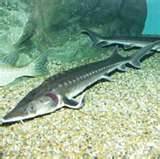Japanese sturgeon facts for kids
Quick facts for kids Japanese sturgeon |
|
|---|---|
 |
|
| Conservation status | |
| Scientific classification | |
| Genus: |
Acipenser
|
| Species: |
schrenckii
|
| Synonyms | |
|
|
The Japanese sturgeon or Amur sturgeon (Acipenser schrenckii) is a type of fish. It belongs to the Acipenseridae family, which includes all sturgeons. This fish lives in the Amur River basin, a large river system found in China and Russia. Some people think it might also live in the Sea of Japan, but we need more proof.
This sturgeon has special bony plates called scutes on its body. It has 11 to 16 scutes on its back. There are 34 to 47 scutes along its sides. It also has 7 to 16 scutes on its belly. Its back fin has 38 to 53 rays. The fin on its underside has 20 to 35 rays. Japanese sturgeons are usually greyish-brown on top. Their undersides are much lighter in color. These fish can grow very large! They can reach up to 3 metres (9.8 ft) in length. They can also weigh over 190 kilograms (420 lb). Sadly, this species is considered to be critically endangered. This means it is at a very high risk of disappearing forever.
Life in the Water: Habitat and Food
The Japanese sturgeon is a benthic fish. This means it lives mostly on the bottom of rivers and lakes. Its main food sources are small creatures. These include aquatic insect larvae, small bony fish, and mollusks like snails.
Scientists have studied what young Japanese sturgeons eat. They found that the type of insect larvae they eat changes with the seasons. In spring and fall, they eat more mayfly nymphs. These are young mayflies that live in the water. In summer, they eat more midge larvae. Midges are tiny flies, and their larvae also live in the water.
Life Cycle and Migration
Female Japanese sturgeons become old enough to have babies when they are 9 to 10 years old. Male sturgeons mature a bit earlier, at 7 to 8 years of age. These amazing fish can live for a very long time. Some Japanese sturgeons have been known to live for up to 65 years! They start to migrate in the autumn. This means they travel to different areas, often to find places to lay their eggs.


